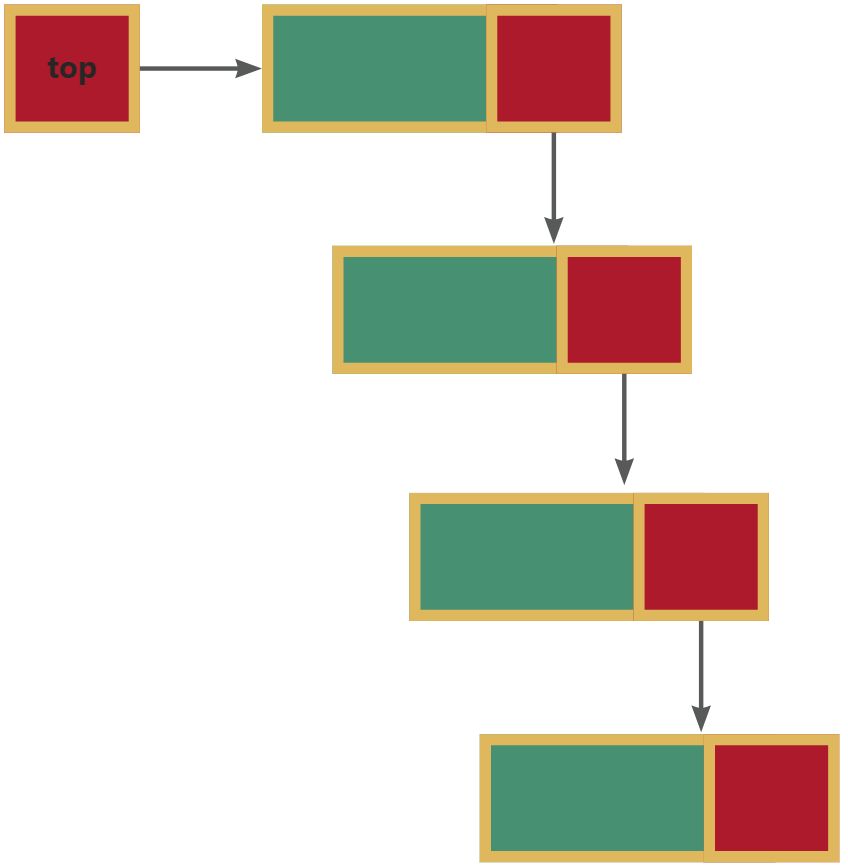1. 概念
链式栈LinkStack
- 逻辑结构:线性结构
- 物理结构:链式存储
- 栈的特点:后进先出
栈具有后进先出的特点,我们使用链表来实现栈,即链式栈。那么栈顶是入栈和出栈的地方,单向链表有头有尾,那我们将链表的头作为栈顶还是链表的尾作为栈顶呢?如果每次在链表的尾部进行插入或删除,就需要遍历整个链表来找到尾结点即终端结点。而在头部即起始结点进行插入或删除时,仅需头指针找到链表的起始结点,而无需遍历整个链表。

所以链式栈的入栈、出栈都是通过对链表进行头插、头删来实现。
既然要对单向链表进行头插、头删,那么头结点的存在会让操作变得复杂,故我们使用无头单向链表。
无头单向链表的头就是栈顶,故栈针是指向无头单向链表的起始结点的,所以我们在链式栈中将头指针H称做栈针top。top栈针永远指向无头单向链表的第一个节点,栈空的时候除外。
对于链栈来说,基本不存在栈满的情况,除非内存已经没有可以使用的空间。
对于空栈来说,链表即H == NULL,链式栈即top == NULL
2. 接口实现
#ifndef _LINKSTACK_H_
#define _LINKSTACK_H_
#include <stdio.h>
#include <stdlib.h>
//入栈和出栈只在第一个节点位置操作
typedef int datatype;
typedef struct linkstack
{datatype data;//数据域struct linkstack *next;//指针域
}linkstack_t;
//1.创建一个空的栈
void CreateEpLinkStack(linkstack_t **ptop);
//2.入栈 data是入栈的数据
//参数上之所以采用二级指针,因为我们要随着入栈添加新的节点作为头,top需要永远指向当前链表的头,那么修改main函数中的top,我们采用地址传递
int PushLinkStack(linkstack_t **ptop, datatype data);
//3.判断栈是否为空
int IsEpLinkStack(linkstack_t *top);
//4.出栈
datatype PopLinkStack(linkstack_t **ptop);
//5.清空栈
void ClearLinkStack(linkstack_t **ptop);//用二级指针,是因为清空后需要将main函数中的top变为NULL
//6.求栈的长度
int LengthLinkStack(linkstack_t *top);//用一级指针,是因为我只是求长度,不需要修改main函数中top指针的指向
//7.获取栈顶数据,不是出栈,不需要移动main函数中的top,所以用一级指针
datatype GetTopLinkStack(linkstack_t *top);
#endif2.1. 定义操作链式栈的结构体
//入栈和出栈只在第一个节点位置操作
typedef int datatype;
typedef struct linkstack
{datatype data;//数据域struct linkstack *next;//指针域
}linkstack_t;2.2. 创建空的链式栈
#include "linkstack.h"
void CreateEpLinkStack(linkstack_t **ptop)
{ //top = NULL;*ptop = NULL;
}#include "linkstack.h"
int main(int argc, const char *argv[])
{linkstack_t *top;CreateEpLinkStack(&top);return 0;
}2.3. 入栈
思想:
开辟新结点存放入栈数据
每次都将新结点链接到无头单向链表的头
栈针top永远指向无头单向链表的头,栈空时除外
顺序栈需要判满,但链式栈无需判满

/*2.入栈 data是入栈的数据
//参数上之所以采用二级指针,因为我们要随着入栈添加新的节点作为头,top需要永远指向当前链表的头,
//那么修改main函数中的top,我们采用地址传递*/
int PushLinkStack(linkstack_t **ptop, datatype data)
{ linkstack_t *pnew = (linkstack_t *)malloc(sizeof(linkstack_t));if(NULL == pnew){printf("PushLinkStack pnew malloc failed\n");return -1;}//给新节点初始化pnew->data = data;pnew->next = *ptop; *ptop = pnew;return 0;
}#include "linkstack.h"
int main(int argc, const char *argv[])
{linkstack_t *top;CreateEpLinkStack(&top);int i;for(i = 0; i < 5; i++){PushLinkStack(&top,i);}return 0;
}2.4. 出栈
顺序栈需要判空即PS->top==-1
链式栈也需要判空即top == NULL
判空无需改变主函数栈针top的指向,故无需传递top的地址。
但出栈后需要移动栈针,改变top的指向,故需要传递栈针top的地址&top。
综上,出栈函数需要传递栈针top的地址&top。
//3.判断栈是否为空
int IsEpLinkStack(linkstack_t *top)
{return top == NULL;
}
//4.出栈
datatype PopLinkStack(linkstack_t **ptop)
{if(IsEpLinkStack(*ptop)){printf("PopLinkStack failed\n");return -1;}datatype temp;linkstack_t *pdel = NULL;
#if 0pdel = *ptop;temp = pdel->data;*ptop = pdel->next;free(pdel);pdel = NULL;return temp;
#endif
#if 1temp = (*ptop)->data;pdel = *ptop;*ptop = (*ptop)->next;free(pdel);pdel = NULL;return temp;
}#include "linkstack.h"
int main(int argc, const char *argv[])
{linkstack_t *top;CreateEpLinkStack(&top);int i;for(i = 0; i < 5; i++){PushLinkStack(&top,i);}
#if 0for(i = 0; i < 5; i++) printf("%d ",PopLinkStack(&top));}printf("\n");
#endifreturn 0;
}4 3 2 1 0 2.5. 栈长
问:求栈长是否需要传递栈针的地址? 无需
问:求栈长能否传递栈针的地址? 可以
//6.求栈的有效长度
int LengthLinkStack(linkstack_t *top)//用一级指针,是因为我只是求长度,不需要修改main函数中top指针的指向
{int len = 0;while(top != NULL){len++;top = top->next;}return len;
}#include "linkstack.h"
int main(int argc, const char *argv[])
{linkstack_t *top;CreateEpLinkStack(&top);int i;for(i = 0; i < 5; i++){PushLinkStack(&top,i);}
#if 0for(i = 0; i < 5; i++){printf("%d ",PopLinkStack(&top));}printf("\n");
#endifprintf("len:%d\n",LengthLinkStack(top));
return 0;
}2.6. 获取栈顶数据
问:获取栈顶数据是否需要移动栈针?
问:获取栈顶数据是否需要传递栈针地址?
获取栈顶数据,部署出栈,无需移动栈针,故无需传递栈针top的地址&top
//7.获取栈顶数据,不是出栈,不需要移动main函数中的top,所以用一级指针
datatype GetTopLinkStack(linkstack_t *top)
{if(!IsEpLinkStack(top)){return top->data;}return -1;
}#include "linkstack.h"
int main(int argc, const char *argv[])
{linkstack_t *top;CreateEpLinkStack(&top);int i;for(i = 0; i < 5; i++){PushLinkStack(&top,i);}
#if 0for(i = 0; i < 5; i++){printf("%d ",PopLinkStack(&top));}printf("\n");
#endifprintf("len:%d\n",LengthLinkStack(top));printf("top_data%d\n",GetTopLinkStack(top));return 0;
}2.7. 清空
只要不空一直出栈
//5.清空栈
void ClearLinkStack(linkstack_t **ptop)//用二级指针,是因为清空后需要将main函数中的top变为NULL
{ while(!IsEpLinkStack(*ptop)){PopLinkStack(ptop);}
}#include "linkstack.h"
int main(int argc, const char *argv[])
{linkstack_t *top;CreateEpLinkStack(&top);int i;for(i = 0; i < 5; i++){PushLinkStack(&top,i);#if 0for(i = 0; i < 5; i++){printf("%d ",PopLinkStack(&top));}printf("\n");
#endifprintf("len:%d\n",LengthLinkStack(top));printf("top_data%d\n",GetTopLinkStack(top));ClearLinkStack(&top);return 0;
}